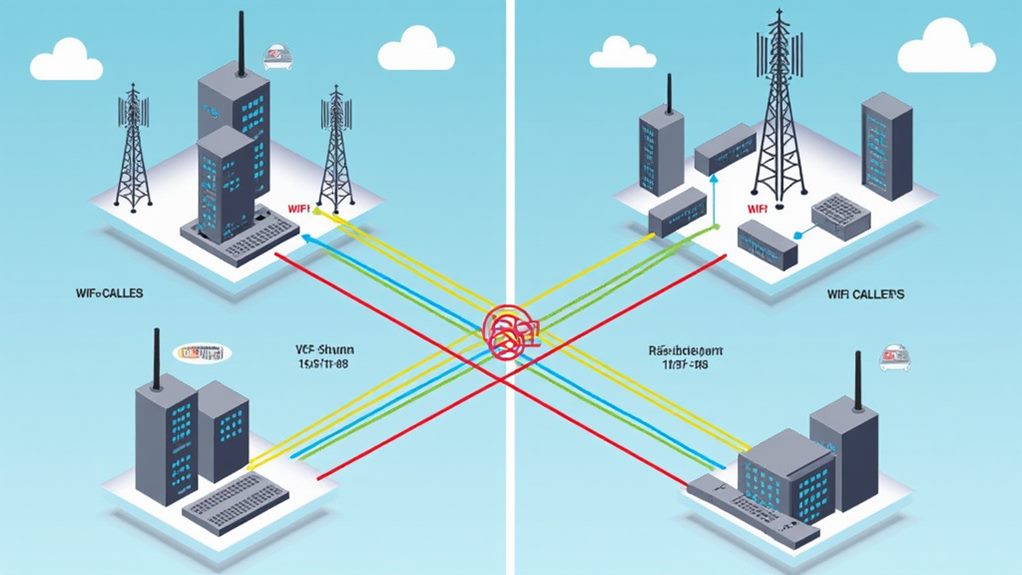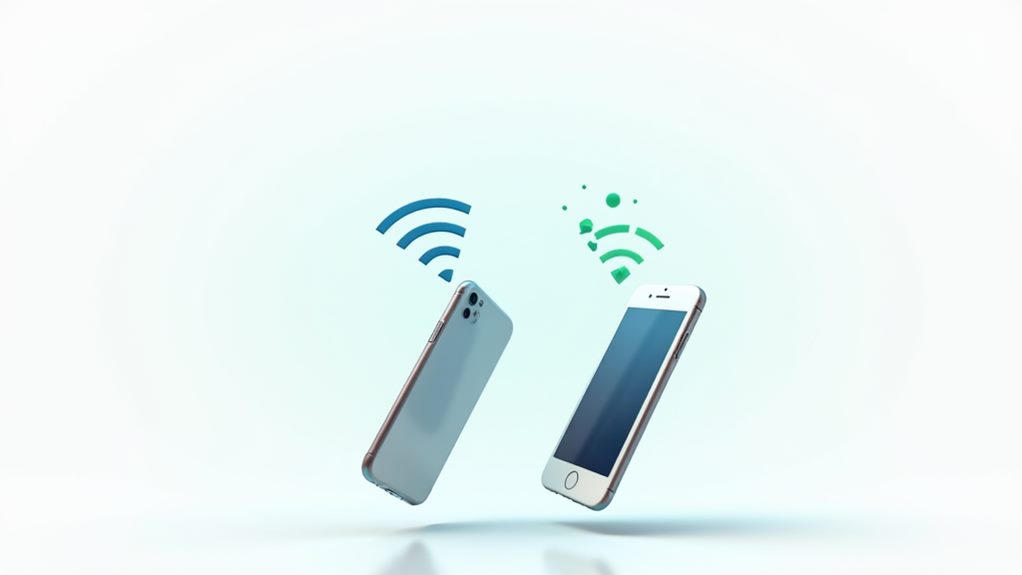While both technologies enable internet-based calling, VoIP and WiFi calling serve different purposes. VoIP converts your voice into digital packets for transmission over the internet, operating independently of mobile carriers and offering advanced features like conference calling and call recording. You'll find it's ideal for business use across multiple devices. WiFi calling, however, works through your mobile carrier's infrastructure, using your existing phone number and plan minutes while automatically switching between WiFi and cellular networks. Your choice depends on whether you need VoIP's versatile business features or WiFi calling's straightforward personal communication approach. Let's explore which solution aligns with your specific needs.
Understanding VoIP Technology

Voice over Internet Protocol (VoIP) fundamentally transforms traditional voice communication by converting analog voice signals into digital data packets for internet transmission. When you use VoIP, you're leveraging advanced technology that operates independently of traditional phone lines, giving you more flexibility and control over your communications.
This process involves multiple steps, including sampling, quantization, and encoding of voice signals, which allows for efficient transmission over the internet. VoIP technology enables you to utilize your existing internet connection, providing a seamless communication experience.
At the core of VoIP's functionality is SIP (Session Initiation Protocol), which manages your calls from start to finish. Unlike WiFi calling, which depends on specific mobile network operators, VoIP works across any internet connection you're using.
You'll find that this technology enables you to make voice communication more versatile, whether you're using a smartphone, computer, or dedicated VoIP phone.
What makes VoIP particularly attractive is its cost-effective nature, especially for long-distance calls. You're no longer bound by conventional telephony pricing structures, and you can greatly reduce your communication expenses.
The system converts your voice into digital data that travels through internet protocol networks, ensuring clear transmission regardless of distance. This technology represents a shift from traditional telecommunications, offering you enhanced features like call forwarding, voicemail, and conference calling capabilities that integrate seamlessly with modern business operations.
WiFi Calling Fundamentals
While VoIP represents a broad technology framework, WiFi calling stands as a specific implementation that's revolutionizing mobile communications. This technology facilitates improved voice quality over WiFi, enhancing clarity and reducing dropped calls. You'll find this technology seamlessly integrated into your modern smartphone, enabling you to make voice calls over any WiFi network when cellular signals aren't ideal.
As a fellow mobile user, you'll appreciate how WiFi calling leverages VoIP technology to transmit voice data packets through the Internet, eliminating the need for additional apps or software. When you enable this feature in your phone's settings, you're joining a network of users who enjoy enhanced call quality, especially in areas where traditional cellular networks struggle to provide coverage.
In addition, the ability to bypass expensive long-distance charges for international calls makes WiFi calling an economical option for travelers cost-effective communication.
What makes WiFi calling particularly attractive is its cost-effectiveness. Your calls are treated just like regular mobile calls, drawing from your existing subscription minutes without incurring extra charges on your mobile plan.
The technology intelligently switches between WiFi and cellular signals to maintain your connection, ensuring you're always using the strongest signal available. This automatic changeover happens behind the scenes, providing you with an uninterrupted calling experience as you move between different coverage areas.
Key Technical Differences

Understanding the technical architecture of VoIP and WiFi calling reveals fundamental differences in how these technologies operate. While both enable voice communication over the internet, their underlying infrastructures serve distinct purposes.
VoIP operates independently of mobile network providers, transmitting voice data directly through Internet protocol packets using diverse platforms, including computers and smartphones, which enhances accessibility advanced VoIP features.
In contrast, WiFi calling (VoWiFi) routes communications through your carrier's existing infrastructure.
You'll notice that VoIP doesn't require a SIM card or mobile subscription, making it versatile across multiple devices. In contrast, WiFi calling is intrinsically linked to your mobile service, requiring both a SIM card and active carrier plan.
When you initiate a call, VoIP services use dedicated applications, whereas WiFi calling seamlessly integrates with your phone's native dialer, displaying your regular mobile number to recipients.
The technical aspects also affect call quality differently – VoIP performance depends on your overall internet connection, while WiFi calling quality fluctuates based on specific WiFi network conditions.
These technical distinctions explain why you might choose one over the other: VoIP offers greater flexibility and potential cost savings, while WiFi calling provides a familiar experience that's fully integrated with your existing mobile service.
Business Vs Personal Use
Today's business communication demands fundamentally shape how organizations and individuals choose between VoIP and WiFi calling solutions.
If you're running a business, you'll find that VoIP systems offer the extensive features you need, including advanced call management capabilities, multi-line support, and seamless integration with your existing business applications. You'll also benefit from cost-effective international calling rates and the ability to manage calls independently of your location.
For personal use, WiFi calling provides a straightforward solution that works well with your existing mobile devices. While you won't get the broad features of VoIP, you'll have reliable calling capabilities through your mobile network when connected to WiFi.
However, you should note that WiFi calling typically follows your standard mobile plan rates, which may not offer the same cost savings as VoIP for international calls.
Consider your device compatibility needs as well. VoIP systems work across various platforms and devices, making them ideal for business environments where flexibility is essential.
In contrast, WiFi calling is limited to smartphones with carrier support, which isn't typically an issue for personal use but could restrict business operations requiring more diverse communication tools.
Network Requirements and Performance

Since network performance directly impacts call quality, understanding the distinct requirements of VoIP and WiFi calling is essential for superior communication.
VoIP requires a stable internet connection, whether through Wi-Fi or mobile data, and you'll enjoy the freedom of making calls without relying on a mobile network operator or SIM card. Your call quality depends on your overall internet performance, so you'll want to guarantee sufficient bandwidth and minimal network congestion for prime voice communication.
WiFi calling, however, operates within your mobile network operator's ecosystem. You'll need a compatible device, an enabled subscription, and operator-specific software to use this service. While you're connected to Wi-Fi, your call quality is influenced by both the Wi-Fi signal strength and underlying network conditions.
This integration with your carrier's infrastructure means you're still bound to your mobile number and subscription services.
When choosing between these technologies, consider your network environment. If you have reliable internet access, VoIP offers greater flexibility and location independence.
Meanwhile, WiFi calling provides a seamless extension of your regular mobile service when cellular coverage is limited but Wi-Fi is available.
Making the Right Choice
When you're deciding between VoIP and WiFi calling, start by comparing their core features: VoIP's advanced business capabilities versus WiFi calling's basic functionality for personal use.
You'll need to evaluate whether you require VoIP's device flexibility and scalable features like conference calling and call forwarding, or if WiFi calling's seamless integration with your mobile plan and strong performance in weak cellular areas better suits your needs.
Your choice should ultimately align with your primary usage patterns: business operations typically benefit from VoIP's extensive feature set, while individual users might find WiFi calling's straightforward approach more practical.
Compare Core Features First
Choosing between VoIP and WiFi Calling requires a clear understanding of their core features and capabilities. When you're evaluating these voice call services, you'll need to examine several key aspects that differentiate them.
VoIP offers you greater flexibility with its platform-independent nature and advanced features. You'll have access to thorough business tools like call forwarding, voicemail, and conference calling across multiple devices, including your desktop and laptop.
However, you'll need to take into account that call quality depends heavily on your internet connection's overall stability.
WiFi Calling, on the other hand, integrates directly with your mobile network through operator support. While it's limited to smartphones and offers basic call functionality, you won't need to worry about separate pricing models since it typically uses your existing call minutes.
The service's quality relies specifically on your WiFi signal strength.
Evaluate your primary use case: if you're looking for a business-oriented solution with extensive features, VoIP might be your best choice.
However, if you simply need a reliable backup for making calls when cellular coverage is poor, WiFi Calling could be sufficient.
Remember that VoIP's varied pricing models offer more flexibility, especially for international communications.
Assess Your Usage Needs
Now that you understand the core features, determining your specific usage requirements will shape your decision between VoIP and WiFi calling. Start by evaluating your primary calling patterns and essential functionality needs.
For business requirements, VoIP offers advanced features like call recording and multi-line calling that you won't find with basic WiFi calling. If your work involves frequent international calls, you'll benefit from VoIP's cost-effective rates compared to standard mobile plans.
Consider your internet reliability, as VoIP demands a stable connection for ideal performance, while WiFi calling can function effectively even in areas with poor cellular coverage.
Device compatibility plays an important role in your decision. If you need to make calls across multiple devices, VoIP's flexibility allows you to use smartphones, desktops, and laptops. WiFi calling restricts you primarily to smartphones and depends on operator support.
Don't overlook emergency services requirements – both options may have limitations, but WiFi calling typically offers better emergency call support than VoIP. Assess whether your usage needs align more with VoIP's thorough business features or WiFi calling's straightforward personal communication capabilities.
Final Thoughts
VoIP and WiFi calling are like two sides of the same digital communication coin, but you'll need to choose based on your specific needs. While VoIP offers robust business features and flexibility across multiple devices, WiFi calling is your built-in solution for personal use. Consider your bandwidth requirements, call volume, and desired features when deciding. Both technologies have revolutionized voice communication, making traditional phone lines increasingly obsolete.

